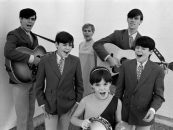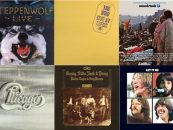Recorded just six months after the completion of the debut album from Cream, Disraeli Gears delivered on the promise only partially heard on its predecessor. Without otherwise altering their format, the trio broke through the British blues guard rails that had confined Fresh Cream, honing their virtuosic interplay to a sharper edge and adding a more modern sensibility spiked with psychedelia.
Until then, Cream’s stature as rock’s first supergroup still begged an asterisk. Ginger Baker, Jack Bruce and Eric Clapton were bold-faced names to British press and fans, but Clapton alone enjoyed name recognition across the pond. All three were still viewed primarily through the lens of the ’60s British blues and R&B boom that had besotted the Rolling Stones, the Animals, the Yardbirds and other fledgling rockers. Baker and Bruce were alumni of the seminal Graham Bond Organisation while Clapton had left the Yardbirds after deeming their first major single hit, “For Your Love,” too close to pop, fleeing to the stylistic purity upheld by John Mayall and the Bluesbreakers.
Listen to Clapton with the Powerhouse, predating Cream
The guitarist was already nurturing ambitions as a front man when Baker approached him in the early summer of 1966 with the idea of teaming up. Clapton was receptive, already inspired by the “huge, powerful sound” projected by one of his heroes, Buddy Guy, but he threw Baker a curve with his candidate for bass, Jack Bruce, unaware of the friction between Baker and the Scottish bassist while they played in Graham Bond’s band. Exploratory jam sessions helped quell Baker’s misgivings, however, on the strength of their collective power. By August the trio was juggling live gigs with their first studio sessions, nominally produced by manager Robert Stigwood but effectively self-produced, released in November of ’66.
Related: Baker is mourned by fellow rock legends
Enter Ahmet Ertegun, legendary Atlantic Records chief, then scouting English rock talent and keen to capture Clapton. If he heard the trio’s potential, he also heard the debut album’s weaknesses, swapping in their subsequent U.K. single, “I Feel Free,” to strengthen the ATCO version of Fresh Cream that followed in January. More crucially, he huddled with the band to review new material and recruited bassist, composer and songwriter Felix Pappalardi as producer. For added insurance, he invited the band to record in Atlantic’s New York studio with their gifted and versatile top engineer, Tom Dowd.
Listen to “Sunshine of Your Love”
Ertegun’s choice was quickly vindicated. “Strange Brew” took “Lawdy Mama,” a traditional blues shuffle arranged by Clapton, and transformed it from the bottom up. Initially, Pappalardi and Clapton slowed the brisk tempo to a slower, strutting pace and added bursts of guitar, retaining the original melody and lyrics before shifting gears for a more substantial rewrite. Pappalardi and wife Gail Collins grafted a new melody that tipped Clapton’s vocal toward falsetto, then replaced standard-issue blues tropes with new lyrics transforming its subject into “a witch of trouble in electric blue,” setting up the album’s frequent reliance on lysergic lyric imagery that was vividly reflected in Martin Sharp’s day-glo cover art and back cover collage.
Listen to the mono version of “Strange Brew” from Disraeli Gears
Related: Read a 2012 interview with Jack Bruce
Clapton’s vocal lead on the opening track likely reflects Ertegun’s primary interest in Clapton as Cream’s focal point, but Jack Bruce remained the group’s strongest and most distinctive singer as well as its most prolific songwriter. On “Sunshine of Your Love,” written by Bruce, poet Pete Brown and Clapton, it’s Bruce’s supple voice that begins the first verse before trading lines with Clapton, the duo harmonizing on choruses just as Bruce’s bass line echoes the song’s signature guitar riff, and enduring hook, with pinpoint precision.
Listen to the band perform “Tales of Brave Ulysses” for the BBC
The album’s breakout hit, “Sunshine of Your Love” showcased Baker’s sinewy drumming. As comfortable with avant-garde jazz as blues, Baker pares his playing to weave in and around his partners’ voices and instruments, relying more on tom-toms and bass drum, applying cymbal splashes sparingly. Onstage and in the studio, the parity between the three players helped define the sensibility of a power trio; the jazz instincts shared by Baker and Bruce further reinforced this principle against more conventional notions of a rhythm section as underlying the front men. Baker’s power enabled him to shift from a pure rock lockstep to swing convincingly when needed, as demonstrated on an up-tempo “SWLABR,” punctuated by pivoting time signatures between its verses. (The title, incidentally, stands for She Walks Like A Bearded Rainbow.)
Clapton, meanwhile, was both inspired and provoked by a new force to reckon with—Jimi Hendrix, who had landed in London in September 1966 and jammed with Cream on October 1 in a performance that left the British musician “completely gobsmacked” by Hendrix’s take-no-prisoners stage presence. Hendrix’s subsequent debut fronting his own trio had to generate added pressure for Clapton and Cream, arguably stealing some of the spotlight cast on their own first album. It’s no surprise, then, that Clapton sought a denser tone and new effects for the sophomore set, including his first experiments with the wah-wah pedal also heard in Hendrix’s work.
Listen to Cream perform “Lawdy Mama” from the Disraeli Gears sessions
Clapton used the effect most effectively on “Tales of Brave Ulysses,” a tense, minor-keyed Clapton/Martin Sharp original sung by Bruce. Its title image of the Homeric hero’s “naked ears…tortured by the sirens sweetly singing” provided fertile ground for Clapton’s ominous soloing.
Overall, the album relied less on blues covers and retreads. Originals by Bruce and Clapton, variously collaborating with Pete Brown, cover artist Martin Sharp and Pappalardi in partnership with Gail Collins distanced them further from standard blues progressions; lyrically, the writing garnished more conventional love songs with bursts of florid melodrama; (“World of Pain”) and stabs at surrealism (“SWLABR”). The net result was an album that succeeded more as a platform for the trio’s technical prowess than songwriting.
Listen to a demo version of “SWLABR”
Disraeli Gears gained its strength and clarity without eating up studio time—Cream recorded the album in five days, May 11 through 15, 1967, with release following on November 2. The LP easily surpassed its predecessor in sales and critical success, peaking at #5 on the British charts and splitting its U.S. rankings, reaching #4 in Billboard, #6 in Record World and #1 in Cash Box. The May ’67, launch of the Jimi Hendrix Experience may have overshadowed Fresh Cream, but Disraeli Gears nearly erased the gap in chart impact. (The Hendrix set would enjoy a longer run, as well as victory on a second front with its R&B chart run on Billboard.)
Felix Pappalardi and Tom Dowd would be on board for 1968’s Wheels On Fire and ’69’s final Goodbye, with Dowd to continue a long and fruitful relationship with Clapton throughout his solo career. Pappalardi would find success with his own power trio, Mountain, fronted by Leslie West, but was forced to retire because of partial deafness, possibly as a result of Mountain’s high-decibel stage shows. He would die in 1983 after being shot by his wife, Gail Collins Pappalardi, who would be convicted of criminally negligent homicide.
Watch Cream perform “Sunshine of Your Love” live in 1968







5 Comments so far
Jump into a conversationOnce I first heard this album I couldn’t get enough of it… it became a touchstone in my journey as a rock and roll fan. Sunshine of Your Love may be my all time favorite track. This is a great article thank you!
FYI. “Ulysses” was the first collaboration between guitarist Eric Clapton and artist Martin Sharp. Clapton composed the music, inspired by the Lovin’ Spoonful’s 1966 hit “Summer in the City”. “I just started chatting to Eric”, said Sharp, who lived in the same building. “I told him I had written a poem. He, in turn, told me he’d written some music. So I gave him my poem. Two weeks later, he turned up with it on the B-side of a 45 record.”
https://en.wikipedia.org/wiki/Tales_of_Brave_Ulysses
A couple corrections that are necessary:
First:
SWALBR is NOT “She Was Like A Bearded Rainbow” but “She WALKS Like A Bearded Rainbow”
Second: Tales Of Brave Ulysses was NOT written by Bruce/Brown but it WAS written by Clapton and Martin Sharp (Disraeli Gears’ cover artist)
Thanks. Corrections made.
I’m still trying to figure out “Wrapping Paper”. Imagine Frank Sinatra taking a shot at it.